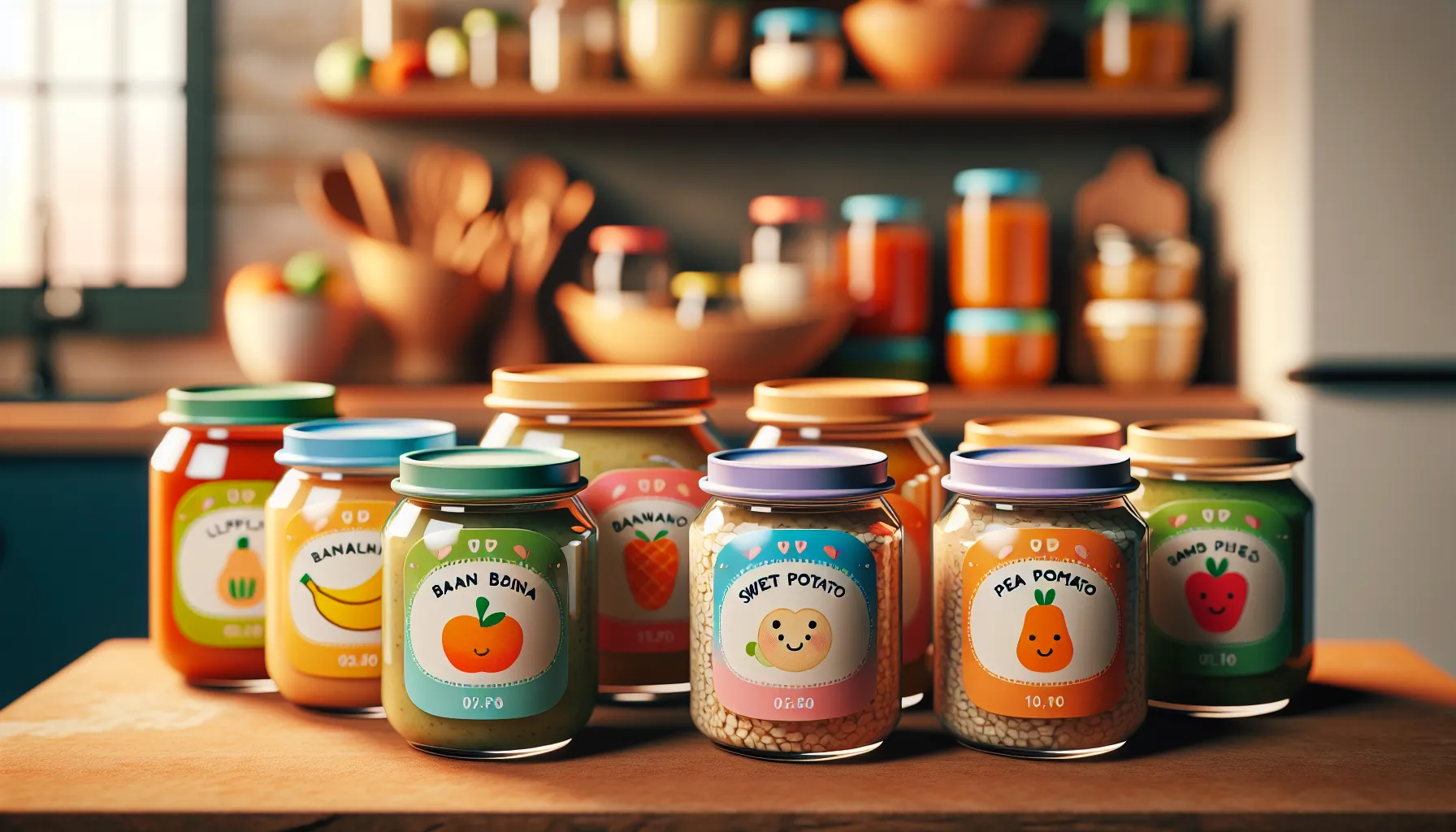Table of Contents
ToggleAs your little one embarks on the exciting journey of solid foods, the quest for delicious and nutritious baby food recipes becomes a top priority. Between the giggles and the inevitable mess, parents are often left wondering what culinary delights can keep their tiny taste testers happy and healthy. Fear not! There’s a world of flavors waiting to be explored that’s not just good for baby but also easy for busy parents.
Overview of Baby Food for 12-18 Months
At 12 to 18 months, babies transition to a more varied diet, incorporating a wider range of flavors and textures. Nutritional needs grow as babies become more mobile and active. Balanced meals ensure adequate intake of essential vitamins and minerals, supporting their rapid development.
Fruits and vegetables provide crucial nutrients, while grains offer energy. Lean proteins aid in growth, contributing to muscle development. Dairy products supply calcium, vital for bone health.
Parents can introduce finger foods, which encourage self-feeding skills. Pieces of soft-cooked vegetables, small fruit cubes, and whole grain toast serve as excellent options. Meals can include simple combinations, like mashed sweet potatoes with finely chopped spinach or oatmeal mixed with pureed fruits.
Hydration remains important during this stage. Water serves as the primary drink, with whole milk introduced gradually after the first year. Limit sugary beverages, which can lead to poor dietary habits.
Allergies may emerge during this period, so it’s wise to introduce common allergens cautiously. Foods such as eggs, dairy, and nuts should appear one at a time, allowing observation of any reactions.
Cooking methods can enhance flavor and texture. Steaming retains nutrients, while baking can create appealing options like veggie muffins. Purees can transition to soft-chopped meals, inviting babies to explore new tastes.
Getting creative with recipes can make mealtime enjoyable. Combining different foods promotes preference for a diverse diet. Implementing seasonal ingredients can also keep meals fresh and exciting.
Nutritional Needs of Toddlers
Understanding the nutritional needs of toddlers is crucial during this developmental stage. As they move more and explore their surroundings, their dietary requirements change significantly.
Essential Nutrients for Growth
Essential nutrients play a vital role in supporting toddlers’ growth and development. Protein contributes to muscle development, while iron supports cognitive function and energy levels. Calcium strengthens bones and teeth, promoting a solid foundation for physical activities. Healthy fats, such as those found in avocados and fish, support brain health and development. Fiber aids digestion and can be found in fruits, vegetables, and whole grains. Vitamins A, C, and D ensure overall health, boosting immunity and enhancing skin health. Each nutrient is crucial for balanced growth, allowing toddlers to thrive as they become more active.
Balanced Meal Planning
Balanced meal planning provides a framework for effective nutrition during this stage. Meals should include a variety of food groups to ensure adequate nutrient intake. Incorporating fruits and vegetables brings vitamins and minerals essential for health. Whole grains, like oats and brown rice, provide energy that keeps toddlers active throughout the day. Lean proteins, found in chicken, fish, and legumes, promote muscle growth and repair. Dairy products offer calcium and vitamin D, important for developing strong bones. Parents can prepare meals focusing on color and texture, making them visually appealing and engaging for toddlers.
Easy Baby Food Recipes
A variety of simple recipes makes mealtime enjoyable for toddlers aged 12 to 18 months. These meals incorporate essential nutrients and flavor, ensuring that little ones receive balanced nutrition.
Breakfast Ideas
Oatmeal offers a warm, hearty start to the day. Cook rolled oats with whole milk for extra creaminess, then mix in mashed banana or diced pears for sweetness. Scrambled eggs provide protein and are easy to chew. Add small pieces of spinach or cheese for additional nutrition. Fruit smoothies blend yogurt, berries, and spinach for a refreshing option. Smoothies are perfect for introducing new flavors while keeping textures smooth and manageable.
Lunch Options
Quinoa salad combines fluffy quinoa with diced cucumber and cherry tomatoes. Parents can dress the salad lightly with olive oil and lemon juice for flavor. Mini whole grain wraps filled with hummus and shredded turkey create a hearty lunch option. Finger-friendly bites like cheese cubes and soft-cooked broccoli enhance texture. Lentil soup provides protein and fiber, making it both filling and nutritious. Serve with soft bread for dipping to promote self-feeding.
Dinner Variations
Sweet potato mash makes for a delicious side, incorporating tender sweet potatoes blended with butter. Incorporating carrots and peas into this mash adds color and nutrients. Baked chicken strips, coated lightly in breadcrumbs, offer a crispy texture that many toddlers enjoy. Serve alongside roasted vegetables for added flavor and nutrients. Pasta with tomato sauce and finely chopped vegetables serves as an easy-to-eat dinner. Enhancing the sauce with herbs provides additional taste and encourages food exploration.
Healthy Snacks for Toddlers
Snacks can play a vital role in a toddler’s diet, providing essential nutrients and energy for their active lifestyle. Choosing the right snacks promotes healthy habits and keeps little ones satisfied between meals.
Homemade Snack Ideas
Homemade snacks offer a great opportunity to control ingredients and introduce wholesome foods. Consider fruit slices paired with nut butter for added protein and healthy fats. Yogurt mixed with crushed berries provides a tasty, nutritious treat. Another option includes baked sweet potato fries seasoned with a sprinkle of cinnamon. Tiny cheese cubes combined with whole grain crackers make for a simple, satisfying snack. Vegetable sticks like cucumber or bell peppers with a yogurt dip encourage kids to taste new flavors. Offering a variety of textures keeps toddlers engaged with their food while promoting healthy eating habits.
Store-Bought Alternatives
Certain store-bought snacks cater to nutritional needs while ensuring convenience for busy parents. Look for whole grain puffs made with minimal ingredients, perfect for little hands. Snack bars can serve as a quick option, focusing on low sugar and whole food ingredients. Fruit and veggie puree pouches offer a mess-free way to incorporate nutrients. Assistive options like yogurt-covered raisins provide a fun sweet snack while still being healthy. It’s essential to read labels carefully, prioritizing those with no artificial additives. Such snacks can satisfy cravings and ease mealtime prep, allowing parents to serve nutritious options without hassle.
Tips for Introducing New Foods
Start with familiar flavors to ease the transition. Mixing new foods with favorites often helps toddlers accept them. Gradual introductions of one new food at a time allow for easier digestion and observation for reactions.
Offer a variety of textures. Exposure to both smooth and chunky foods expands a child’s palate. Incorporating small pieces of soft-cooked fruits and vegetables encourages self-feeding exploration.
Model positive eating behaviors. Eating meals together creates a social environment that promotes interest in trying new foods. Demonstrating enjoyment while eating different foods can motivate toddlers to follow suit.
Involve toddlers in food preparation. Simple tasks like washing veggies or stirring ingredients can increase their excitement about meals. Encourage participation to create a sense of ownership over their food choices.
Maintain a calm and relaxed atmosphere during mealtime. Stress can hinder a child’s willingness to try new foods. Setting a positive tone ensures dining remains a pleasant experience.
Reintroduce foods after initial rejection. Many toddlers need multiple exposures before accepting new flavors. Patience is key, as tastes can change over time.
Be persistent but avoid pressure. Offering new foods repeatedly without forcing consumption allows them to explore at their own pace. Praise for trying new foods, even just a small taste, fosters a positive relationship with eating.
Keep meal times consistent and establish routines. Regular schedules help toddlers anticipate mealtime, creating a sense of security. A familiar routine encourages curiosity about new tastes.
Gradually adjust portions to match their growing appetites. Tracking serving sizes can ensure balanced nutrition and prevent overwhelm. By emphasizing healthy choices, parents set the foundation for lifelong eating habits.
Navigating the world of baby food for toddlers aged 12 to 18 months can be both rewarding and challenging. With a focus on balanced nutrition and diverse flavors parents can foster healthy eating habits that last a lifetime. By incorporating a variety of textures and colors into meals toddlers are more likely to explore and enjoy their food.
As they grow and develop their preferences parents should remain patient and persistent. Encouraging self-feeding and involving toddlers in meal preparation can make mealtime a fun experience. With the right recipes and a positive approach parents can ensure their little ones receive the essential nutrients needed for healthy growth and development.







